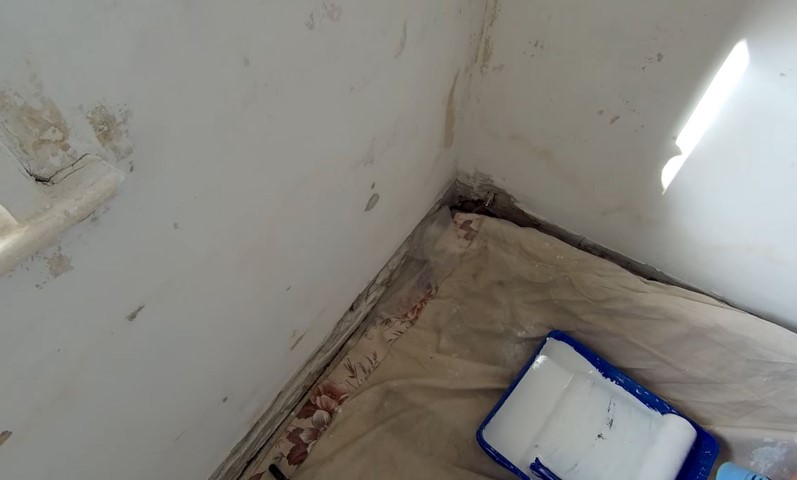There is a poor ceiling stain in your home, and painting is not an option for you? Not a problem. Water stains in the ceiling often indicate that there is a water leakage behind those ceiling tiles. Our article can be an excellent guide for you if you want to know how to remove water stains on the ceiling without painting.
Brown spots in the ceiling are the ultimate result of a leaky rooftop. When the infected area of your ceiling becomes saturated with water, the water spots begin to show up. If left unchecked, it can seriously mess with your ceiling color, texture and eventually deteriorate the overall environment of your home.
How To Remove Water Stains On The Ceiling?
There are a few steps to be followed to remove water stains from your ceiling. Here, in our article, we will write down each step in a subsequent order. Let’s begin with identifying the source of the leak.
Identifying the Source of Leak
In order to find out where the source of the leakage is, you must have access to the attic. Grab a flashlight and try looking around with bare eyes. If you notice any soppy area or mold around, that is the possible source of water spots on your ceiling.
However, if there is a mesh of insulation network around the attic, you need to remove them from the possibly affected part. And look for any damp area around the attic.
In any case, there are pipes in the possible area of leakage, look through the pipes. Inspect them carefully and look for any corrosion, crack, or verdigris (green patina) on them. Often, a leak in the old rusty pipes above your ceiling or rooftop can cause poor yellow or brown stain on the ceiling beneath their location.
What Kind of Ceiling Do You Have?
Nowadays, many types of textured ceilings are seen around us, what’s more! These textured ceilings have gained immense popularity within a short period. They are sophisticated and smart in appearance.
While the most common ceiling types we find in our residents are seamless and flat, other textured ceilings like orange peeling, skip trowel, popcorn ceiling, and swirled ceiling are also noticeable.
Textured ceilings often require chunky nap rollers (¾ inch to 1 inch and 1 and ½ inch to 1 and ¼ inch). Their form of construction is such that only a few regular accessories for stain removal will be valid for them. You can also use quality stain-blocking primers on textured ceilings specially made for them.
Plaster Ceiling or Else
Your ceiling can be made of any of these materials: wood, plaster, concrete, drywall, or standard ceiling tiles. The appropriate process for removing water spots on the ceiling after heavy rain depends on the type of medium you have used to build the ceiling.
Wooden ceilings are delicate in nature. And they should be cleaned with a proper solution of water and hydrogen peroxide.
When it comes to the concrete ceiling or standard ceiling tiles, you can use a regular sprayer made especially for removing stains or any other methods.
However, water damage will eventually lead to scraps of plasters falling off your ceiling when it comes to plaster ceiling. In this case, after properly cleaning the area, you can use a light homemade solution of bleach to clean the infected part.
Prepare your Materials
Now that we have acquainted with different types and materials of the ceiling. It is time to move on to the next part of our article.
Hard water stain on the ceiling in an apartment can never be removed completely. However, you can conceal them using proper materials and solutions. To approach the process of concealing, you need certain accessories like a drop cloth, protective gears, and appropriate paint rollers, a putty knife, sponge, ladder, and of course, a proper solution for removing wall stains. Once you are ready, you only need to follow these steps accordingly.
Clear and Cover Your Floors and Furniture: Use a drop cloth to cover the floor and furniture in your room. Amenities that are hard to wash, like cushioned sofa or seats, must be covered thoroughly. Remove your electrical gadgets to any other room.
Take Necessary Protection: When taking necessary measures for ceiling leaks, ensure you have all the proper protective gear. Most of the stain blocking primers contain VOCs, even a small amount. It is mandatory to avoid health hazards using necessary gloves, masks, and eye goggles while working.
Even with home remedies like bleach chlorine solution or vinegar, they can be extremely toxic to human skin if kept exposed for too long.
Make the Bleach Solution: While many other chemical mixtures like chlorine or oxygen bleach can be applied to remove water stain; let’s suppose for now, we are using a bleach solution.
Water sports in the ceiling don’t require more than a mild bleach solution. And you can easily make it with three cups of warm water and one cup of bleach. This light bleach solution will easily remove the remaining mildew, dirt, or stains.
Use Ladder to Reach Ceiling: Do not use any fragile seat or table to reach the ceiling. Use step ladders to do the job and keep safety in mind always.
Sponges for Removing The Bleach Solution: When lifting the bleach solution, do not use any regular piece of soaking cloth. Always use a sponge and saturate it with bleach solution using a glove.
You can also use a magic eraser sponge to remove stains from the ceiling. Magic erasers work efficiently against wall-stains due to their special cleaning agent inside.
Bleach the Stain
We are almost final to removing stubborn stains from the damaged ceiling. Once you have reached the ceiling with a bleach-saturated sponge in hand, start rinsing the water-damaged area of your ceiling.
Bleach is an excellent solution for removing dust or grease stains. It is also easily available around you.
Rinse and Repeat
Cleaning once is not enough. Water stains are very stubborn. It would be best to wipe over the affected area back and forth. And repeat the process several times until no or very little residue of stain is left behind.
Let it Dry and Try again If necessary
Once you are done with the entire process, let your ceiling dry. Once it is completely dry, rinse over that specific part again if you notice any residue of hard stains left unchecked.
How Do I Stop the Stain from Bleeding Through?
Bleed through is a naturally occurring phenomenon in wooden furniture. It acts like a stain and mainly appears due to the presence of tannins in the wood. Tannins are water-resolvable substance that is acidic. It is present in most plant food, responsible for decreasing plant growth and net efficiency.
Bleed through can appear in any wooden furniture, even if they are painted. However, it is mostly noticed with dark-colored woods like mahogany or walnut.
It is wise to stop this wood stain from bleeding through at an early stage; before applying paint to it. Fortunately, there are many bleeds through block primers available. You can use any of them to lock this odd-looking wood stain. I suggest Zinsser Bulls Eye Shellac. It is around the corner and affordable on a budget.
How Do I Find the Cause of the Stain on My Ceilings?
While looking for the source of stain on your ceiling, you should cross-check these three parts of your home several times.
Plumbing Leaks
Plumbing leaks are the common reason for most of the leakage in households. If a plumbing network is located in your ceiling, it can be an approximate source of leaking. Although plumbing pipes are hidden below the construction, you can easily check for leaks using a water meter.
Up On the Roof Top
While looking for sources of leaks, start with your rooftop. There can be many penetration ports in your roof that can be compromised. I mean plumbing lines, ventilation systems, chimneys, and even dormers by penetration ports.
Without any passageway inward, there shouldn’t be any vulnerable point in your roof, even if it is too old.
No Leaks? More Ventilation
Even with a headstrong search, you cannot find any leak? Then check for your ventilation system. Our household ventilation network is supposed to drive away moisture, humidity, and warmth outside our house to balance inner and outer pressure.
However, skipping your knowledge, some ventilation tubes or hoses may lead to the attic inside your house. This can result in slow dampening, leading finally to ceiling stains.
Can You Paint Over Water Damage?
Yes, you can paint over water damage. Although our article is about getting rid of water stains from the ceiling without using paint, you can paint over water-spoiled areas as long as they are not drooping or bowing down.
Final Words
“How to Remove Water Stains on the Ceiling Without Painting” is a common question to many people suffering from stubborn water ceiling damage. In many cases, painting over water stains is not an effective option. Hence our article today is for those who prefer alternative solutions to water damage avoiding painting.

